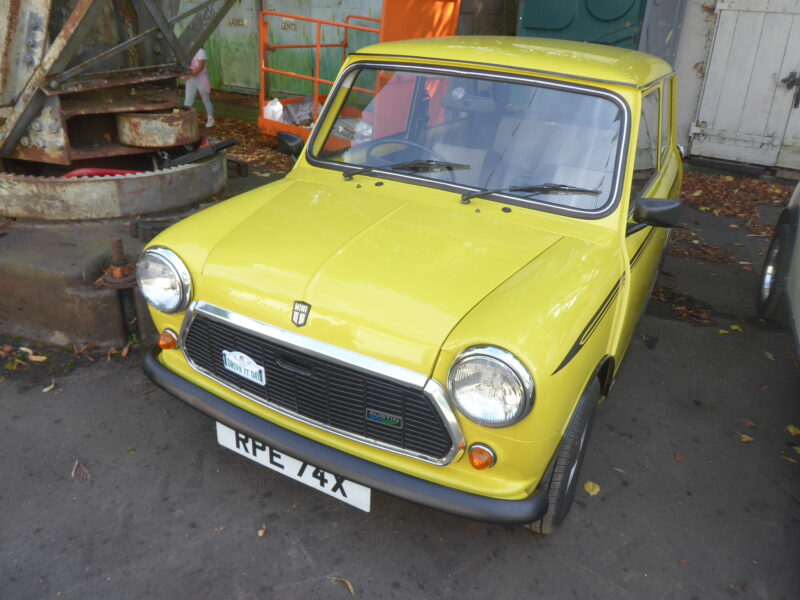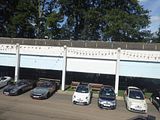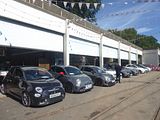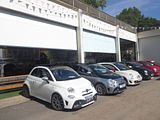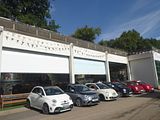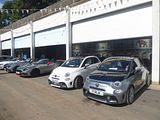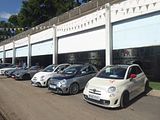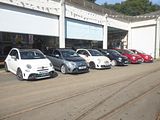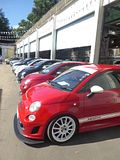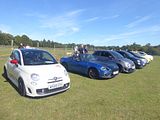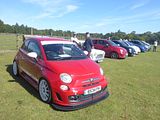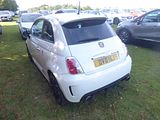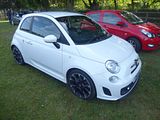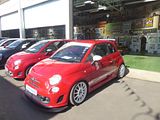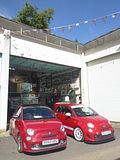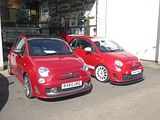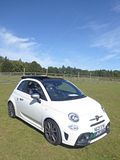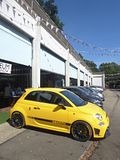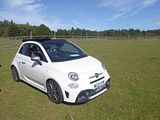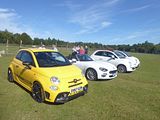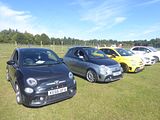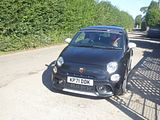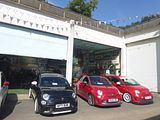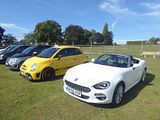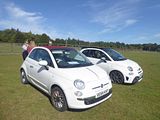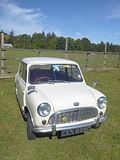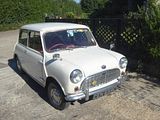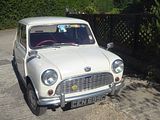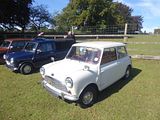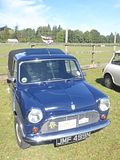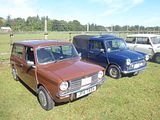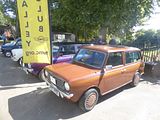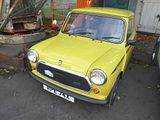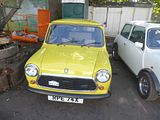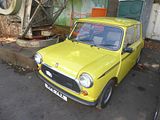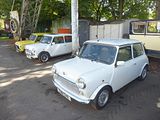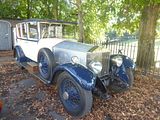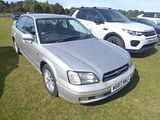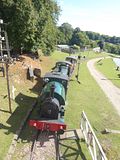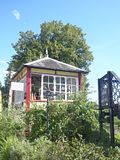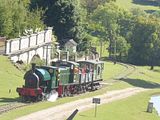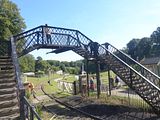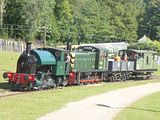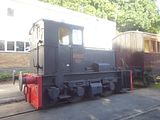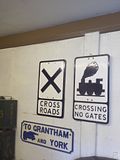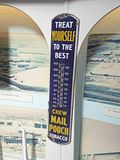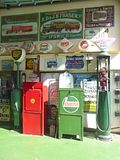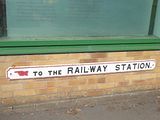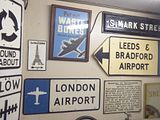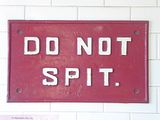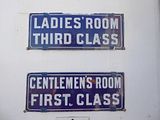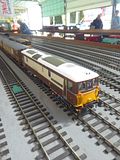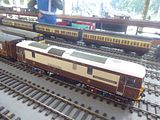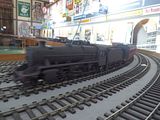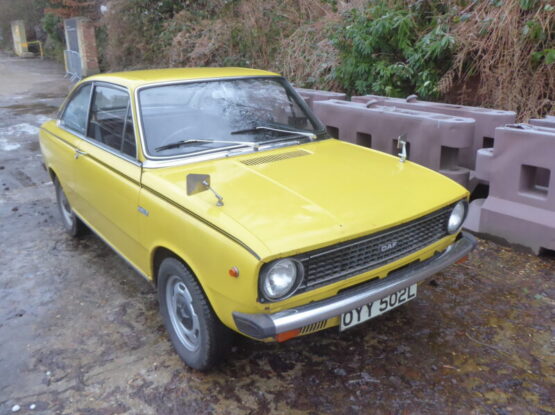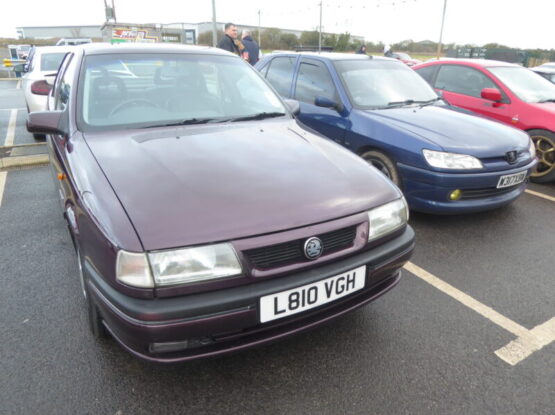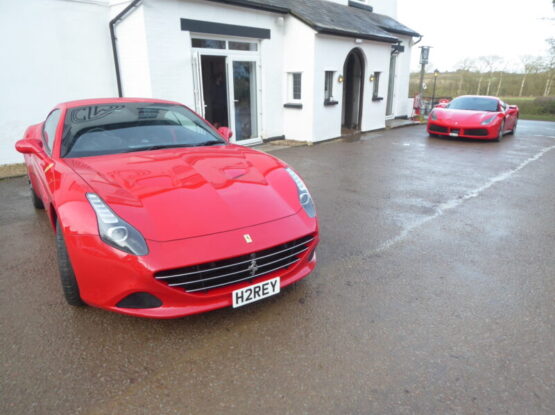In April 2023, I was able to visit Fawley Hill, location of a privately owned operational railway combined with a huge collection of railway and other period memorabilia. When I said “yes” to going, I confess I’d never even heard of Fawley Hill, and its location is such that you would be extremely unlikely to come across it by accident. Located in the centre of the MacAlpine estate, home to the late Sir William and the current Lady MacAlpine, it is in perhaps the most improbable location of all for a railway, as it is in a valley in a valley in a valley, a few miles north of Marlow, but accessible only by single track roads from any direction. It is completely disconnected from the railway network, so everything here has to be brought in, or take out, by road, and getting transporters that can carry even a small steam loco here must be one of the more challenging things for a driver to do. Even the idea of getting a coach here is hard to conceive and yet seeing them in the car park suggests that it is possible. Thankfully I did not meet any on the approach! Because the collection is privately owned, it is open to the public only on a very limited basis, no more than a handful of times a year. And even when it is open, you cannot just turnup, but you have to have a response to your request for a visit approved, as there is a real need to restrict the numbers of people attending. Car Clubs are able to get some form of priority by applying early enough. In 2023 I was able to go as part of an Abarth Club Berkshire visit arranged by a Club member who also volunteers at the site and who had been able to put the Club on the list. For this visit, I was able to work directly with the venue and got lucky in having a slot approved, towards the end of the season. Numbers needed to be strictly controlled, but in the end that was not a problem as roughly the same number of people asked to attend as the capacity I had been given. Our allotted day turned out to be one of those late summer ones where the weather seems not quite to have caught up the calendar and we were blessed with abundant sunshine for the entire duration of the visit. Here are the photographic highlights from the day.
THE DISPLAY CARS
There is space for a subset of the visiting cars to park up right in the centre of the location, which is obviously popular as this allows proud owners to get pictures of their cars (and others) with an interesting backdrop. I doubt you would ever get to do this if you came by yourself as opposed to as part of a Club approved visit.
ABARTH and FIAT
When we first arrived, and made it through the main gate up on the roadside, they were still not quite ready for cars actually in the core of the site, so we were asked to assemble in the car park area and wait for a few minutes until they could get us parked up right in the centre of the venue. That meant that there was a chance to get a first batch of photos in the field and a second set with the cars parked with some of the restored buildings as backdrop.
The vast majority of cars here were the 500-based models which have been on sale now since the end of 2008, following a launch at the Paris Show that year. Since that time there have been a number of detailed changes to the standard cars and a lot of limited editions. Those who really know the marque can spot most of them, but some are so subtle that unless there is a badge you can see, you will not be quite sure which version you are looking at. It used to be relatively easy, when the model was first launched, as there was only one version as shipped ex works called the 500. It had a 135 bhp 1.4 litre turbo-charged engine coupled to a five speed manual gearbox, with 16″ alloys as standard, and the option of 17″ wheels, and a colour palette comprising of two whites (BossaNova White, the standard colour, or the pearlescent Funk White), Red (Pasadoble), Pale Grey (Campovolo) or Black. If you wanted more power – 160 bhp – then you could order an Esseesse kit, which came in a large wooden crate, containing new wheels, springs, an ECU upgrade, the Monza exhaust system and badging. It was dealer fitted and could be applied at any time within the first 12 months or 10,000 miles from registration. Needless to say, it proved popular. As were many of the optional extras, with stickers for the sides, a large scorpion for the bonnet and even a chequered pattern for the roof among the personalisation options offered. Of the earliest cars here, there was the 500 Esseesse belonging to Richard and Mandy Newland, the somewhat modified/personalised Pasadoble Red car of Paul Hatton and David Robinson’s car which is a Series 1 car even though he has made some of the visual changes which were introduced on later factory models.
Rumours started to circulate towards the end of 2014 that Abarth were going to upgrade the Competizione model, so as better to bridge the gap between the Turismo and the 190 bhp 695 Biposto that had been added to the range earlier in the year. It was Geneva 2015 when the result was finally shown to an expectant fan base. Most exciting news was that thanks to a bigger Garrett Turbo, the engine had been tweaked to 180 bhp, and with reduced CO2 emissions. A standard spec that included Koni Dampers, Brembo brakes, Xenon lights, Sabelt seats, Climate Control, parking sensors as well as other refinements that had been added like the TFT instrument display all proved very compelling, so not long after the first cars reached the UK in June of 2015, I found temptation too hard to resist, and as is well documented here, swapped my 2010 car for one of these. At the time I ordered it, Cordolo Red, a tri-coat pearlescent paint which shimmers in bright sunlight looked set to become one of the most popular colours of the lot, even though it is a cost option. Indeed, the Launch Edition models were all offered either in this colour or Scorpion Black, with black wheels. Surprisingly, the colour was not carried over to the Series 4 cars. A new colour was announced with the new Competizione cars, called Podium Blue, but it was not going to be immediately available, and there were no accurate representations of exactly what shade it would be. Rumours circulated on Abarth forums and Facebook Groups all summer, with lots of guessing and no real facts, although we had been assured that it was not the same as the Abu Dhabi Blue that had featured on a very small number of 695 Tributo Ferrari models in 2011. It was October 2016 when the first cars reached the UK and those who had taken the gamble could see for themselves whether they had got it right. Common consent is this is a stunning colour. A rich blue, it changes shade in different lights. I think it looks fantastic. It has proved very popular and remains on offer to this day.
Most of the Abarth models here were what is known as the Series 4 version of the familiar 595, which reached the markets in the middle of 2016. After rumours had circulated all winter following the launch of the facelifted Fiat 500 last year, Abarth finally unveiled the Series 4 at the end of May 2016. Initially, we were told that the cars would not be available in the UK until September, but that came forward somewhat, with dealers all receiving demo cars in June, and the first customers taking delivery in July. Three regular production versions of both the closed car and the open-topped C were initially available, all badged 595, and called Custom, Turismo and Competizione, as before, though numerous limited edition models have since appeared and in most case disappeared. The most significant changes with the Series 4 are visual, with a couple of new colours, including the much asked for Modena Yellow and a different red, called Abarth Red, which replaces both the non-metallic Officina and – slightly surprisingly – the tri-coat pearlescent Cordolo Red. as well as styling changes front and rear. The jury is still out on these, with many, me included, remaining to be convinced. At the front, the new air intake does apparently allow around 15 – 20 % more air in and out, which will be welcome, as these cars do generate quite a lot of heat under the bonnet. Competizione models for the UK retain the old style headlights, as they have Xenon lights as standard, whereas the Custom and Turismo cars have reshaped units. At the back, there are new light clusters and a new rear bumper and diffuser. Inside, the most notable change is the replacement of the Blue & Me system with a more modern uConnect Audio set up, which brings a new colour screen to the dash. Mechanically, there is an additional 5 bhp on the Custom (now 145) and Turismo (now 165 bhp) and the option of a Limited Slip Diff for the Competizione, which is likely to prove a popular option. Details of the interior trim have changed, with a filled-in glovebox like the US market cars have always had, and electric windows switches that are like the US ones, as well as a part Alcantara trim to the steering wheel in Competizione cars. These cars have now been on offer for eight years and with Abarth sales on the rise, it was no surprise that they were particularly well represented here.
More recently, Abarth have produced the 695 Rivale, a celebration of Fiat’s partnership with Riva, which has already seen a special Riva version of the 500,. Described as being “the most sophisticated Abarth ever”, it is available either as a hatch or a cabriolet, with both of them featuring a two-tone Riva Sera Blue and Shark Grey paintwork. The Rivale is adorned with an aquamarine double stripe, satin chrome finish on the door handles and satin chrome moulding on the tailgate, various aesthetic elements inspired by the Riva 56 Rivale yachts and ‘695 Rivale’ logos, joined by Brembo Brakes, Koni suspension, and 17-inch Supersport alloy wheels. Enhancing the nautical theme the new 695 Rivale features either a carbon fibre or mahogany dashboard, black mats with blue inserts, blue leather seats and door panels, carbon fibre kick plates, special steering wheel wrapped in blue and black leather and with a mahogany badge, blue leather instrument panel cover, and mahogany gear lever knob and kick plate. These are joined by the standard Uconnect infotainment with a 7-inch display, which is compatible with Android Auto and Apple CarPlay, and there is also a hand-written numbered plate that can be customised with the mane of the customer’s yacht on request. Powering the 695 Rivale is the same 1.4-litre turbocharged engine that makes 180PS (177hp) and 184lb/ft of torque, that features in the 595 Competizione, allowing it to go from rest to 100km/h (62mph) in 6.7 seconds and up to a top speed of 225km/h (140mph). This is a regular model in the range, but confusingly, there is also the Abarth 695 Rivale 175 Anniversary, created to celebrate 175 years of the Riva brand. Just 350 of these were produced, half of them the hatch and the other half cabriolets. These featured 17-inch alloy wheels with a special pattern, celebratory badge on the outside, hand-crafted details such as the two-tone colour – blue and black hand-stitched leather seats with a celebratory logo stitched onto the headrest, carbon dashboard silk screen printed with special logo, numbered plate. Standard Rivale cars arrived in the UK in April 2018, and quite a few have been sold. They always attract lots of interest when they do appear.
A top of the range 595 Esseesse model was added in early 2019. These cars have only sold in quite small numbers, so you don’t see them that often. The most obvious change externally is the adoption of the neat white painted 17inch multi-spoke alloy wheels that are an Esseesse trademark, while elsewhere it gets the same recently reprofiled bumpers as the standard 595. Inside, there’s a pair of bespoke figure-hugging Sabelt high-backed seats with a carbonfibre shell and some natty red stitching, while carbonfibre trim also covers the pedals and the dashboard. Under the bonnet is the familiar 178bhp turbocharged 1.4-litre engine, but here it breathes in through a BMC filter and exhales from a switchable carbonfibre-tipped Akrapovič twin exit exhaust. There’s no more power than the old Competizione, but the Esseesse gets that model’s Brembo callipers for its 305mm front discs, plus a limited-slip differential. The suspension is largely carried over, including Koni’s frequency selective dampers. All this comes at a price though, and so this has remained a relatively rare sighting compared to the Competizione which many still feel offers rather better value for money. For 2022, the badging was changed so the Esseesse is now branded a 695 rather than a 595 and there were minor spec changes.
We had a couple of examples of the Abarth 124 Spider here. The Abarth 124 Spider was developed in parallel with the Fiat model. It does cost a lot more, and there are those who think you don’t get enough extra for your money, but those who have driven it will tell you otherwise. You certainly get more power. The 1.4 MultiAir turbo unit jumps up from 138bhp to 168bhp, while torque also increases by a modest 10Nm to 250Nm, which gives it a 0-62mph time of 6.8 seconds, which is half a second quicker than the 2.0-litre Mazda MX-5. The top speed is 143mph. It weighs just 1060kg meaning a power-to-weight ratio of 158bhp-per-tonne, and with the new Record Monza exhaust system it sounds great even at idle. The Abarth version gets a stiffer suspension setup than the regular Fiat 124 Spider, with Bilstein dampers and beefed-up anti-roll bars. Bigger Brembo brakes also feature, with aluminium calipers. It can be had with a six-speed manual or six-speed automatic transmission with paddles, and the latter gets a Sport mode for quicker shifts. Many of the UK cars sport the ‘Heritage Look’ pack, which is a no-cost option. It brings a matt black bonnet and bootlid, plus red exterior trim detailing and has proved popular. The £29,565 starting price gets you standard equipment such as cruise control, climate control, Bluetooth, a DAB radio and satnav, plus Alcantara black and red (or pure black) seat trim. The automatic gearbox is a £2,035 extra, while an optional visibility pack brings LED DRLs, auto lights and wipers and rear parking sensors. Sales ceased during 2019, with around 1800 cars having been brought into the UK, so this is always going to be a rare car, and values are already increasing at a rate reflecting its desirability and the difficulty in finding one.
Joining us were examples of the Fiat versions of both the 500 and the 124 Spider.
MINI
The other Club attending on the day was one for the Mini and there were a number of nice examples of the much-loved Issigonis classic here.
The Mini was marketed under BMC’s two main brand names, Austin and Morris, until 1969, when it became a marque in its own right. The Morris version was known to all as “the Mini” or the “Morris Mini-Minor”. This seems to have been a play on words: the Morris Minor was a larger, well known, and successful car that continued in production, and minor is Latin for “lesser”, so an abbreviation of the Latin word for “least” – minimus – was used for the new even smaller car. One name proposed for the almost identical Austin version was Austin Newmarket, but it was sold as the Austin Seven (sometimes written as SE7EN in early publicity material – with the ‘7’ using the letter V rotated anticlockwise so it approximated the number 7), which recalled the popular small Austin 7 of the 1920s and 1930s. Until 1962, the cars appeared in North America and France as the Austin 850 and Morris 850, and in Denmark as the Austin Partner (until 1964) and Morris Mascot (until 1981). It was introduced in Australia as Morris 850 only (not “Austin”), and then later as Morris Cooper and Morris Cooper S versions, as well. The Morris name Mini (Mini-Minor) was first used for Austin’s version by BMC in 1961 when the Austin Seven was rebranded as the Austin Mini, somewhat to the surprise of the Sharp’s Commercials car company (later known as Bond Cars), who had been using the name Minicar for their three-wheeled vehicles since 1949. However, legal action was somehow averted, and BMC used the name “Mini” thereafter. In 1964, the suspension of the cars was replaced by another Moulton design, the hydrolastic system. The new suspension gave a softer ride, but it also increased weight and production cost. In 1971, the original rubber suspension reappeared and was retained for the remaining life of the Mini. From October 1965, the option of the unique Automotive Products designed four-speed automatic transmission became available. Cars fitted with this became the Mini-Matic. Slow at the outset, Mark I sales strengthened across most of the model lines in the 1960s, and production totalled 1,190,000. Ford purchased a Mini and dismantled it to see if they could offer an alternative. Ford determined that the BMC must have been losing around £30 per car, so decided to produce a larger car – the Cortina, launched in 1962 – as its competitor in the budget market. BMC insisted that the way company overheads were shared out, the Mini always made money. Larger profits came from the popular De Luxe models and from optional extras such as seat belts, door mirrors, a heater, and a radio, which would be considered necessities on modern cars, as well as the various Cooper and Cooper S models. The Mini entered into popular culture in the 1960s with well-publicised purchases by film and music stars.
Without doubt, the rarest version of the classic Issigonis-designed Mini is the Pickup, as seen here. Introduced in 1961, at the same time as the Van, whose longer platform this version shared, there was an open-top rear cargo area and a drop down tailgate. The factory specified the weight of the Pick-up as less than 1,500 lb (680 kg) with a full 6 gallon tank of fuel. As with the Van, the Pick-up had stamped metal slots for airflow into the engine compartment. The Pickup was basic, although the factory brochure described a “fully equipped Mini Pick-up is also available which includes a recirculatory heater.” Passenger-side sun visor, seat belts, laminated windscreen, tilt tubes and cover were also available at extra cost. Equipment levels improved gradually over time. Like the van, the Pick-up was renamed as the Mini 95 in 1978. Production ceased in 1983 by which time 58,179 Mini Pick-up models had been built, barely 10% of the number of Vans made.
In 1969, now under the ownership of British Leyland, the Mini was given a facelift by stylist Roy Haynes, who had previously worked for Ford. The restyled version was called the Mini Clubman, and had a squarer frontal look, using the same indicator/sidelight assembly as the Austin Maxi. The Mini Clubman was intended to replace the upmarket Riley and Wolseley versions, and a new model, dubbed the 1275 GT, was slated as the replacement for the 998 cc Mini Cooper, the 1,275 cc Mini Cooper S continuing alongside the 1275 GT until 1971. The Clubman Estate replaced the Countryman and Traveller. The original “round-front” design remained in production alongside the Clubman and 1275 GT. Production of the Clubman and 1275 GT got off to a slow start because the cars incorporated “lots of production changes” including the relocation of tooling from Cowley to the Longbridge plant: so very few cars were handed over to customers before the early months of 1970. Early domestic market Clubmans were still delivered on cross-ply tyres despite the fact that by 1970 radials had become the norm for the car’s mainstream competitors. By 1973 new Minis were, by default, being shipped with radial tyres, though cross-plies could be specified by special order, giving British buyers a price saving of £8. The most significant update after this came in 1976, when the engine was upgraded to the 110cc A Series unit, cloth seat trim was made standard and the wiper functions were moved to a column stalk. The stick on “wood” trim was replaced by painted coachlines at this time. The Clubman models were deleted in 1980, effectively replaced by the Metro, and they are relatively rare these days. The 1275 GT is often incorrectly described as the “Mini Clubman 1275 GT”. The official name was always just the “Mini 1275 GT”, and it was a separate, distinct model from the Clubman (although it shared the same frontal treatment as the Mini Clubman, and was launched at the same time). It had the 1275cc A Series unit and a 4 speed gearbox, as well as larger wheels. It was also deleted in the autumn of 1980. Although moderately popular when new, it is now seen as something of a poor substitute for the Cooper models, and the survival rate is pretty low, so you don’t see them that often.
The Mark IV was introduced in 1976, though by this stage British Leyland was working on a new small car which was widely expected to replace the Mini before much longer. It had a front rubber-mounted subframe with single tower bolts and the rear frame had some larger bushings introduced, all intended to improve the car’s mechanical refinement and to reduce noise levels. Twin column stalks for indicators and wipers were introduced, as were larger foot pedals. From 1977 onwards, the rear light clusters included reversing lights. In July 1979 the lower end of the Mini range was altered. The basic Mini 850 (which had featured in various forms since the original launch 20 years before) was withdrawn. Its place was taken by two models at slightly lower and slightly higher price points. The new base model was the Mini City, with black-painted bumpers, an untrimmed lower facia rail, part-fabric seats and wing mirror and sun visor only on the driver’s side, plus unique ‘City’ body graphics and boot badge. Above the City was the new 850 SDL (Super Deluxe), which had the same specification as the standard Mini 1000 but with the smaller engine. In August 1979 the Mini’s 20th anniversary was marked by the introduction of the first true limited-edition Mini, which was the Mini 1100 Special. This was a 5,000-car run with the 1098 cc engine, broadly to the specification already in production for the European market as a standard model with the same name. However this was the first time a UK-market ’round-nose’ (i.e. non-Clubman) Mini had been available with the 1098 cc engine, and the UK limited edition was also fitted with unique Exacton alloy wheels – the first time these were fitted to a factory-produced Mini – and plastic wheelarch extensions. Inside was the 1275GT’s three-dial instrument cluster and a leather-rimmed wheel with a rectangular centre from the Innocenti Mini hatchback. The 1100 Special and 850 City models were phased out by 1980, and during the same year the engine was upgraded to the improved A-Plus unit from the new Metro in 998 cc form, which was now the only engine available in the Mini. This was then followed by a number of incremental developments. In 1978, the Mini was one of the key cars made available to disabled motorists under the new Motability scheme. Reports of the Mini’s imminent demise surfaced again in 1980 with the launch of the Austin Mini-Metro (badging with the word “mini” in all lowercase). Faced with competition from a new wave of modern superminis like the Ford Fiesta, Renault 5, and Volkswagen Polo, the Mini was beginning to fall out of favour in many export markets, with the South African, Australian, and New Zealand markets all stopping production around this time. Buyers of small cars now wanted modern and practical designs, usually with a hatchback. The Metro was therefore in essence, the Mini mechanicals repackaged into a larger hatchback bodyshell. Although the Mini continued to be produced after the Metro’s launch, production volumes were reduced as British Leyland and its successor Rover Group concentrated on the Metro as its key supermini. The original Mini’s last year in the top ten of the UK’s top selling cars was 1981, as it came ninth and the Metro was fifth. The arrival of the Metro also had production of the larger Allegro pruned back before it was finally discontinued in 1982. In 1982, BL made 56,297 Minis and over 175,000 Metros. Due to their common powertrain package, the Mini received many mechanical upgrades in the early 1980s which were shared with the Metro, such as the A-Plus engine, 12-inch wheels with front disc brakes, improved soundproofing and quieter, stronger transmissions. This not only modernised the Mini but, because many of its major sub-assemblies were now shared with the Metro, made it very cost-effective to produce despite falling sales volumes.
With the larger Metro being redesigned in 1990 to take the new K-Series engine, the Mini became the sole recipient of the classic A-Series engine with transmission-in-sump layout. The engine mounting points were moved forward to take 1275 cc power units, and includes the later Horizontal Integral Float version of the SU carb, and also the single-point fuel-injection version, which came out in November 1991. The 998 cc power units were discontinued. Early, carburetted Coopers had a catalytic converter and produce 60 bhp at 5500 rpm. Power crept up to 62 bhp at 5700 rpm for the fuel injected model. An internal bonnet release was fitted from 1992. By 1991, the Cooper represented forty percent of Mini sales in the home market; the main export market was Japan. Production ended in August 1996 as the Mark VII replaced it.
Also here is a resident and rather splendid car, a 1927 Rolls Royce Phantom I Thrupp & Maberly. Rolls-Royce’s ‘single model’ policy had proved to be an outstanding success for the company, but immediately after the end of the Great War the recession in the motor trade prompted the introduction of a smaller, cheaper 20hp car to be built alongside the existing 40/50hp Silver Ghost. Henry Royce’s new design incorporated a number of modern features such as overhead valvegear for its six-cylinder engine, a centre-change gearbox, and ‘Hotchkiss drive’ rear axle, and the advanced newcomer’s arrival only served to emphasise the Silver Ghost’s Edwardian origins. However, the 45/50hp model would soon benefit from developments pioneered on its smaller sibling. Introduced in 1925, the New Phantom (retrospectively known as the Phantom I) boasted an entirely new overhead-valve six-cylinder engine displacing 7,668cc, and like the 20hp adopted a disc-type clutch and adjustable radiator shutters. Its chassis though, remained essentially the same as that of the later four-wheel-braked ‘Ghost, and would continue fundamentally unchanged until the arrival of the Phantom II in 1929 brought with it an entirely new frame. Despatched to London-based coachbuilder Thrupp & Maberly in April 1927, New Phantom long-wheelbase chassis number ’91EF’ was sold via Rootes Ltd of Piccadilly to first owner Colonel M A Swinfen-Brown of Lichfield, who service records indicate owned the car until at least 1938. Restored around 1970, the vehicle came into present ownership in 1977 and has been maintained since then by recognised marque specialists as recorded by numerous accompanying invoices. Finished in cream/blue with leather/cloth upholstery,
OTHER
I did venture up to the main car park during the day to see if there was anything of note parked up there, and, slightly surprisingly, there really wasn’t. almost everything being modern current product, but this Subaru Legacy did grab my attention.
There was also an Austin-Healey Sprite here. The Mark II to Mark IV cars were all very similar and represented the evolution of the model throughout the 1960s, The Mark II was announced at the end of May 1961. It used the same 948 cc engine with larger twin 1 1⁄4 inch SU carburettors, increasing power to 46.5 bhp. A close-ratio gearbox was fitted. The bodywork was completely revamped, with the headlights migrating to a more conventional position in the wings, either side of a full-width grille. At the rear, styling borrowed from the soon-to-be-announced MGB gave a similarly more modern look, with the added advantages of an opening boot lid and conventional rear bumper bar. The result was a much less eccentric-looking sports car, though at the expense of some 100 lbs extra weight. It followed the MG version of the car which was introduced a couple of weeks earlier as ‘the new Midget,’ reviving a model name which had been a great success for the MG Car Company in the 1930s. The Midget was to prove more popular with the public than the Sprite and by 1972 had completely supplanted it within the BMC range. In October 1962, both Sprites and Midgets were given a long-stroke 1098 cc engine. A strengthened gearbox with Porsche (baulk-ring) synchromesh was introduced to cope with the extra power – 56 bhp. Front disc brakes were also introduced at the same time and wire wheels became an option. 31,665 Mark II Sprites were made. The Mark III Sprite was also marketed as the Mark II MG Midget – differences between the two were again restricted to minor trim detailing. Although still 1098 cc, the engine had a stronger block casting, and the size of the crankshaft main bearings was increased to two inches. A new (slightly) curved-glass windscreen was introduced with hinged quarterlights and wind-up side windows. Exterior door handles were provided for the first time, with separate door locks. Though the car could now be secured, with a soft-top roof the added protection was limited. The rear suspension was modified from quarter-elliptic to semi-elliptic leaf springs, which gave a more comfortable ride for a near-negligible weight penalty as well as providing additional axle location, the upper links fitted to the quarter-elliptic models being deleted. Though scarcely sybaritic, these changes helped the Sprite and Midget compete with the recently released Triumph Spitfire. 25,905 Mark III Sprites were made. The next upgrade was presented at the London Motor Show in October 1966. Besides receiving the larger 1275 cc engine (which disappointed enthusiasts by being in a lower state of tune than that of the Mini-Cooper ‘S’), the Mark IV and its cousin the Mark III MG Midget had several changes which were more than cosmetic. Most notable is the change from a removable convertible top, which had to be stowed in the boot, to a permanently affixed, folding top of greatly improved design, which was much easier to use. Separate brake and clutch master cylinders were fitted, as car manufacturers’ thoughts began to turn to making their products safer. For the 1970 model year cast-alloy wheels were fitted and the grille was changed to resemble that fitted to the MG Midget. 22,790 Mark IV Sprites were made. The Healey connection was discontinued in 1971, so the final 1,022 Sprites built were simply Austin Sprites.
THE RAILWAY and GROUNDS
Having looked at the cars, it was time to enjoy the rest of the site. Fawley Hill is the private estate of the late Sir William McAlpine and Lady McAlpine in the heart of the English countryside. Once described by Country Life magazine as ‘the most bonkers estate in Britain’, it is home to a restored Victorian railway station, the steepest standard gauge railway track in the world, a railway museum and over 20 animal species.
The railway began slowly and No. 31 came in its early days: McAlpine’s very last working engine but even she was to be sold for scrap: so Sir William paid her scrap value and said “Send her home.” The story of her progress across the fields to Fawley Hill made it into the national papers. So, as the terrible race to “modernise” gripped the country and historic buildings were pulled down and replaced with concrete boxes (admittedly many being built by McAlpines!) or worse and stations began to close, with so much being broken up, melted down, thrown away: Sir William kept saying “Send it home”.. and everything that came here was carefully preserved and lovingly placed in the garden or the museum which had started life as a home for his traction engines and the family car collection. Eventually, of course, an entire station building was saved, sliced up, loaded onto lorries and brought here from Somersham to be reassembled and to play its part in the magic that is Fawley. Often parked in the station is “GE 1″ the beautiful wooden private Saloon built for the Chairman of the Great Eastern Railway. Being Canadian, he had it built with a “balcony” on which, presumably, to smoke his cigars as he toured his empire. Two carriages from Royal Trains joined the collection: one Her Majesty’s private carriage and one the nursery coach for Prince Charles and Princess Anne. They are now permanently parked and provide occasional spare bedrooms. To this day the museum and railway are maintained and operated by a wonderful team of volunteers.
This time I made sure of a ride on the train. You can go as many times as you like during the day. It is quite a short stretch of track, but it does extend far further than you could walk, even if you cannot get off at the far end of the line, so you simply stay put whilst the arrangements are made to prepare the train for the return journey. To get back to the main station involves a climb which I gather is the steeped on any non-cog railway in the UK, and can be quite a challenge if the track is wet with difficult traction but that was not the case today. There are various lineside artefacts that you can see during the journey.
The railway has gradually been built up from the early beginnings in 1965. The final structure to arrive at Fawley was a footbridge from the Isle of Wight. This arrived in 2000 but had to be reduced in span to suit the space constraints of the site. In was installed in 2001 and now allows visitors to cross the track at any time whilst providing an excellent vantage point for photographs.
The locomotive which hauled the train is called No 31 and is the resident steam locomotive at Fawley. Ordered by the Ministry of Fuel and Power, it was built in 1913 and delivered new to Robert McAlpine & Sons, Cuffley. It was painted in Caledonian Blue, a colour that it retained throughout its working life. It worked on a number of building contracts including Wembley Stadium (1923-1924), RAF Boscombe Down (1944) and Llanwern Steelworks (1960-1961). The locomotive was rebuilt by Hudswell Clark & Co in 1938. No 31 went into storage at McAlpine’s yard at Hayes in 1961 and remained there until it was identified for scrapping in1965. At this point, Sir William decided to give No 31 a new life in retirement and purchased the locomotive. No 31 arrived at Fawley in September 1965 and was subsequently repainted in GWR Brunswick green livery. Above the smokebox door is carried loco shed plate 81M – a code unique to Fawley. At the end of this season, its boiler certificate runs out and No 31 will have to leave Fawley (by road) for a significant overhaul, so this was one of the last chances for people to see the loco before that work commences.
There is another loco here. A total of 230 Class 03 diesel shunter locomotives of were constructed by BR at Swindon and Doncaster, and brought into service between 1957 and 1962. This example, D2120, was built at Swindon and entered service in October 1959. It was first allocated to Danygraig Depot and spent its entire career in the Swansea area of South Wales. In March 1972 whilst on overhaul, D2120 was converted to Burry Port & Gwendraeth Valley (BPGV) Railway loading gauge, one of 11 Class 03’s so converted over the years. The BPGV line had a severe height restriction and this conversion involved reducing the cab height by 4½ inches. During the mid 1970’s BR adopted its TOPS computer numbering system and D2120 was renumbered 03120 in March 1974. As the 03 Class was being reduced in number, 03120 was retained as a standby, allocated to Landore Depot. It was finally withdrawn by BR in February 1986 and released for sale. Purchased by Sir William McAlpine, 03120 arriving at Fawley in December 1986, wearing the standard fleet livery of BR rail blue with ‘wasp’ yellow and black painted warning ends. Since its arrival it has been repainted into early BR Green as D2120; the wasp stripes at each end of the locomotive were restored in 2019. D2120 wears loco shed plate 87C (Danycraig).
There’s some wonderful memorabilia here, with period signs, some of which you just could not use these days! I spent a lot more time wandering up and down the buildings trying to take in room after room of the most varied set of content you could imagine, and realised that there was really rather a lot that I had simply failed to see or even find in 2023. You truly could spend all day looking at the exhibits and still not take everything in, there is so much content here.
The Museum is the permanent home of two working 0 Gauge model railway layouts. Laira was built by John Dornam and has been featured in several model railway magazines. Taking more than five years to build, Laira was exhibited at the Gauge 0 Guild’s annual Guildex exhibition in 1996 and 1998, following which it was acquired by Sir William McAlpine for permanent exhibition in the Museum. The layout depicts the Motive Power Depot near Devonport as it was in the 1950s and is complete with smoke and sound effects. The Wallingford and Watlington Line is approximately 120ft (40m) long and runs along the balcony of the Museum. This highly detailed, 0 Gauge model railway has been built by members of the Fawley Museum Society and depicts the two GWR stations as they would have appeared around the time of their closure in the 1980s. The stations are connected by a single track connection which was planned in real life but never constructed. Started more than 20 years ago, construction of the station layouts has been based on photographic records of the sites and work is still ongoing to complete various items of background detail. On Invitation Days, these model layouts are normally supplemented by William Street, a six-line, 0 Gauge oval track together with temporary exhibits. These include Wharton Road, an impressive Gauge 3 (1:22.6 scale) layout and Fawley Flyers, a 1:76 scale competition entry for The Great Model Railway Challenge. Other visiting exhibition layouts of various gauges, belonging to museum members, put in regular appearances.
As many people are aware, Fawley Hill is also an Animal Sanctuary as accidental in its conception as was the railway. Sir William had been involved with ZSL (London & Whipsnade Zoos) for longer than he cared to remember. He discovered very early on that while all the Zoos in the world (but we concentrate on Europe) constantly move animals around in order to prevent inbreeding and to conserve species which are dying out in the wild, there comes a point with most species where there is an imbalance: too many males usually. This is where Fawley came in. Zoos cannot afford to keep “spare” men who just loaf about and need feeding: so they come here, where they live virtually wild. On site here they are fed each day and there are plenty of houses and shelters but none are allocated and no-one makes the animals “go to bed” at night. Among the animals who live here are: cats, dogs, a multitude of hens, ducks and geese, a plethora of goats; we have red, fallow, roe, axis, sika and hog deer, sitatunga, addax, barasinga, wallabies, reas, emus, peacocks, tapirs, capybaras, alpaca, guanaco, llamas, racoons, coatis, meerkats, porcupines, maras, chinchillas, rabbits, tortoises and lemurs. Our old oryx and nilgai have died of extreme old age. I don’t think I have ever seen so many peacocks as there were here – and if you can’t see them, you will certainly hear them first, as these are not quiet birds!
Helped, for sure, by the glorious weather, everyone really enjoyed this day, some even pronouncing it to be the “best” event of the year that they had attended. It was certainly something quite different from the usual Abarth gatherings and one where you really did have to spend most of the time away from the cars, taking in the attractions of the site. That appeared to be little hardship for those present, who revelled in the displays, the steam train ride, the grounds and simply the chance to sit in the sunshine and to talk. I am told that the site changes very little from year to year, so the only reason not to try to repeat this in 2025 would be if it is largely the same group of people interested, they may find a repeat visit, especially if the weather were less favourable, to be a bit of a disappointment, so given congested events calendar for the coming year, this is probably somewhere to rest for a couple of years before returning. But return, for sure, we will.

